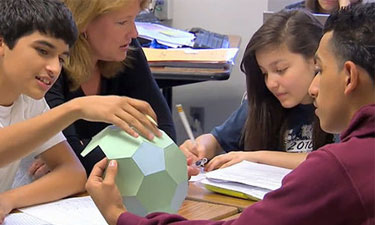Middle School Matters
There is no silver bullet, no single message, program or curriculum to prevent bullying, social isolation and violence. Schools can make great progress by focusing on developing a compassionate and informed staff, supportive school and district leadership, and data driven improvement in knowledge and skills.
These tools for schools have been designed for educators who share our enthusiasm and commitment to middle school students. We all know that it takes resources, vision, and planning to engage and motivate this age group, and we hope the information that follows can help create a school climate environment that motivates both students and the adults to be their very best. As authors Dave Brown and Trudy Knowles have written, “Teaching middle schoolers is not an easy trip, but the ride is exhilarating.”
Middle school is a fascinating time for both young adolescents and the adults in their orbits. As physical and emotional changes occur for youth, with heightened academic expectations and initial steps toward independence, shaping the social norms and culture of the place they spend the majority of their waking hours—school–matters greatly. Many administrators and educators recognize that fostering positive, healthy school climates can help students not only socially but also academically. More and more we are understanding the importance of focusing on the social and emotional side of students’ development and needs.
Understanding how to harness the development occurring in an adolescent brain to maximize positive behavior, establishing more equitable discipline policies and supporting bullying and violence prevention practices are efforts many schools are taking to create a positive and nurturing school climate and culture.
The Developing Brain
Middle school is a critical time in adolescent brain development. The adolescent brain is in transition: During adolescence, the brain is changing and building millions of new connections that allow it to become faster, sharper and smarter. There are also differences in development between girls and boys that can account for many learning and behavioral differences. Understanding adolescent brain development offers an opportunity to respond and teach better based on what science tells us about this stage of development.
The Whole School Approach
A whole school approach is cohesive, collective and collaborative action in and by a school community that has been strategically constructed to improve student wellbeing. The benefits to improved student learning, behavior, attendance and the wellbeing for both youth and adults in a school community are boundless. Learn how schools can take a more compassionate, whole school approach to building a more conducive environment for kids to learn and grow.
Rethinking Discipline
Students must feel safe and supported to learn. Together with creating equitable discipline policies and bullying prevention, instituting restorative practices can help. Building community, engaging in meaningful communication and learning collaboratively are facets of restorative practices important to creating a positive climate in schools. What are the essential aspects of effective restorative practice?
Preventing Bullying and Violence
During the middle school period, it is important to address the combination of bullying, social isolation, homophobic teasing, sexual harassment, dating violence, and gang violence—and understand how these issues and behaviors relate to one another. Developing preventive measures depends on student and parental engagement as well as school leadership and policies that support a safe learning environment.
In part supported by






